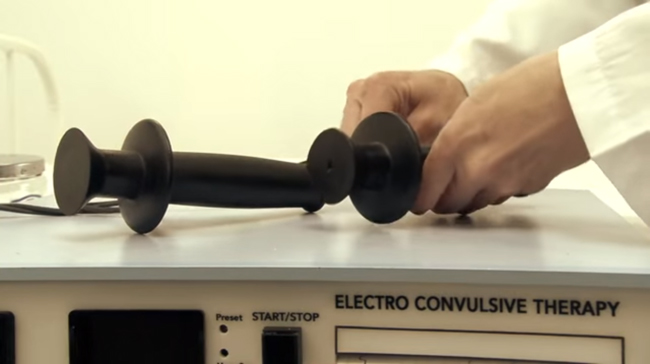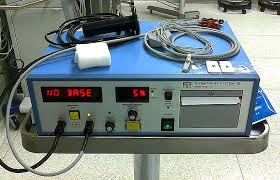By CCHR International
March 10, 2016
A public service announcement (PSA) warning about the documented damaging risks of electroshock treatment has been launched opposing the Food and Drug Administration’s (FDA) plan to reclassify the electroconvulsive therapy (ECT) device as low risk, opening the door to massive widespread use. CCHR and other concerned groups and doctors charge that device makers should fulfill a mandate the FDA gave them in 1979 to provide clinical evidence of safety and efficacy. To date, the shock box has never undergone any clinical studies to prove its safety and efficacy.
Despite this and while acknowledging “significant risks associated with ECT” the FDA plans to reduce the risk classification given the device in 1976 and has given a deadline of March 28, 2016 for people to comment on its proposal. CCHR urges people to report any knowledge of ECT damage by logging onto the FDA site. The ECT device, which sends up to 460 volts of electricity through the brain and is administered to 100,000 Americans every year, is a profitable $1.2 billion a year industry.
You can make a public comment to the Food and Drug Administration (FDA) here: http://1.usa.gov/1P0aMfh
The proposal has come under heated debate with accusations the FDA is ignoring the more than 3,000 earlier submitted comments to the Agency between September 2009 and January 2010, when 79% opposed downgrading the device from its current “high risk” Class III category to low-risk Class II. As the FDA does not regulate medical practice, once it approves the device, it could open the door to widespread use of electroshock, including on children. Already autistic children are being used as experimental subjects in studies. [1]
The FDA lists fourteen health risks associated with ECT, including:
- Death may result from various complications of ECT such as reactions to anesthesia, cardiovascular complications, pulmonary complications, or stroke (impairment of blood flow to the brain or bleeding in the brain).
- Cardiovascular complications: The induced convulsions may be accompanied by arrhythmias (irregular heartbeat) or ischemia/infarction (i.e., heart attack). Hypertension (high blood pressure) and hypotension (low blood pressure) may occur.
- Cognition and memory impairment, specifically immediate post-treatment disorientation, anterograde memory impairment and retrograde personal (autobiographical) memory impairment.
According to an announcement of the pending rule change from the FDA, the agency is proposing changing the classification of ECT devices “for use in treating severe major depressive episode (MDE) associated with major depressive disorder (MDD) or bipolar disorder (BPD) in patients 18 years of age and older who are treatment-resistant or who require a rapid response due to the severity of their psychiatric or medical condition.”
Jan Eastgate, President of CCHR International says: “Because the FDA does not regulate medical practice, classifying the ECT device as Class II for any ‘disorders’ opens the door to a massive potential for off label use and enforced treatment of involuntarily detained patients and children.”
A 2014 study by Cheryl van Daalen-Smith et al. stated: “The ongoing and growing interest within psychiatry in prescribing electroshock or shock-like procedures for treating certain behaviors or conditions deemed psychoneurologic in children is of grave concern, given that the plethora of evidence that electroshock has at its very core an intent to damage and incapacitate the brain appears to be ignored.”
The authors concluded that “given the volume of evidence demonstrating its substantive brain-damaging outcomes, we call for an immediate global ban on the use of electroshock on all children.”[2]
A February 16, 2013, United Nations Special Rapporteur on Torture and Other Cruel Inhuman or Degrading Treatment or Punishment report defined procedures such as electroshock without the consent of the patient as a form of torture.[3]
“It is incumbent upon the FDA, then, to increase the safeguards for the use of medical devices on mental health patients, not reduce them, and thus the ECT device should remain Class III. Anyone concerned about patient protections and safeguarding lives should immediately oppose the FDA’s harmful proposal,” Eastgate said.
References:
[1] Cheryl van Daalen-Smith, et al., “The Utmost Discretion: How Presumed Prudence Leaves ChiIdren Susceptible to Electroshock,” CHILDREN and SOCIETY, Vol. 28, 205-217 (2014), http://www.chrysm-associates.co.uk/images/vanDaalen-Smith&Breggin2014_ECTchildren.pdf.
[2] Ibid.
[3] A/HRC/22/53, “Report of the Special Rapporteur on torture and other cruel, inhuman or degrading treatment or punishment, Juan E. Méndez,” United Nations, General Assembly, Human Rights Council, Twenty-second Session, Agenda Item 3, 1 Feb. 2013, p. 21, para 85, http://www.ohchr.org/Documents/HRBodies/HRCouncil/RegularSession/
Session22/A.HRC.22.53_English.pdf.



